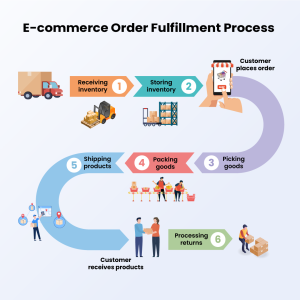The growth of online commerce has transformed how people shop and how businesses operate. At the center of this transformation is ecommerce fulfillment, the unseen process that ensures products move from digital shelves to customers’ doorsteps. It is more than just packing and shipping; it is the foundation of trust, satisfaction, and brand loyalty. Without efficient fulfillment, even the best online stores struggle to survive in a highly competitive environment.

Fulfillment begins long before a package is sealed and sent. It starts with inventory management, where products are stored, tracked, and prepared for sale. Accurate forecasting and organized storage systems are essential to ensure that items are available when customers place orders. Any mistake in this early stage can lead to delays, cancellations, and lost sales opportunities. Read on Ecommerce Fulfillment California for more information.
The next critical step is order processing, which has evolved dramatically with technology. Modern systems can instantly capture online orders, verify payment, and update inventory records in real time. This speed is crucial for maintaining customer expectations in a world where rapid delivery is now the norm. Reviews consistently show that delays during this stage can significantly impact customer satisfaction and repeat purchases.
Packing is more than a logistical task; it is a customer experience touchpoint. The way a product is prepared for shipping affects perceptions of quality and care. Efficient packaging ensures that items arrive safely while minimizing waste and shipping costs. Many businesses now use sustainable materials, not only for environmental reasons but also to meet growing consumer expectations.
Shipping, the most visible part of fulfillment, is also the most complex. It involves selecting carriers, managing delivery routes, and balancing cost with speed. Customers expect fast, reliable, and affordable delivery, and meeting these expectations can be challenging. Strategic decisions in this phase often determine whether a business can compete effectively in the digital marketplace.
One of the most significant developments in ecommerce fulfillment is the rise of automation. Automated sorting, packaging, and tracking systems reduce human error and speed up the entire process. They also allow businesses to handle larger order volumes without compromising efficiency. This shift is particularly important for companies experiencing rapid growth or seasonal spikes in demand.
Another important trend is the integration of data analytics into fulfillment strategies. By analyzing customer behavior, purchase patterns, and delivery performance, businesses can make more informed decisions. Predictive analytics can anticipate demand fluctuations, optimize stock levels, and even reduce shipping costs. This data-driven approach turns fulfillment from a cost center into a strategic advantage.
Customer expectations have reshaped the fulfillment landscape. Fast shipping, accurate tracking, and easy returns are now considered standard rather than premium services. Businesses that fail to meet these expectations risk losing customers to competitors who do. Fulfillment strategies must therefore evolve continuously to stay aligned with shifting consumer priorities.
Reverse logistics, or handling returns, is another critical but often overlooked part of ecommerce fulfillment. A smooth return process can turn a potentially negative experience into a positive one, increasing customer loyalty. Efficient systems for inspecting, restocking, or disposing of returned products help reduce losses and improve sustainability. Companies that excel in this area often see higher repeat purchase rates.
Sustainability has become a defining feature of modern fulfillment strategies. Consumers increasingly favor brands that minimize environmental impact through packaging choices, shipping methods, and energy-efficient operations. Businesses that adopt green logistics not only improve their reputation but also future-proof their operations against evolving regulations. This shift reflects a broader trend toward responsible commerce in the digital age.
Globalization has added new layers of complexity to ecommerce fulfillment. Serving customers across borders requires expertise in customs, taxes, and international shipping regulations. Delays or errors in these areas can result in dissatisfied customers and significant financial losses. Businesses that master cross-border logistics gain access to new markets and growth opportunities.
One of the greatest challenges in fulfillment is balancing speed and cost. While customers demand fast delivery, expedited shipping can be expensive and reduce profit margins. The most successful strategies find ways to optimize shipping networks, use regional distribution centers, or negotiate better carrier rates. This balance is crucial for long-term profitability in ecommerce.
Technology continues to redefine what’s possible in fulfillment. Artificial intelligence, robotics, and the Internet of Things are transforming warehouses into smart, efficient ecosystems. These technologies improve accuracy, speed, and scalability, enabling businesses to handle complex operations with fewer resources. Early adopters often gain a competitive edge by delivering better service at lower costs.
Personalization is another emerging frontier in fulfillment. Data insights allow businesses to tailor delivery options, packaging, and communication to individual customer preferences. Personalized experiences create stronger connections and increase customer loyalty. This evolution shows that fulfillment is not just about logistics; it is a key part of the overall brand experience.
Collaboration within the supply chain has become more important than ever. Fulfillment partners, carriers, and technology providers must work together seamlessly to ensure consistent performance. Strong partnerships allow businesses to respond quickly to disruptions, scale operations efficiently, and improve service quality. This collaborative approach is essential in an era where supply chains are increasingly interconnected.
Security and compliance are also vital components of ecommerce fulfillment. Protecting customer data, ensuring safe payment processing, and adhering to legal requirements are non-negotiable responsibilities. A single breach or regulatory violation can damage a brand’s reputation and result in costly penalties. Proactive risk management helps maintain trust and protects the long-term health of the business.
Customer communication is another area where fulfillment plays a significant role. Real-time tracking updates, proactive notifications, and responsive support all contribute to a positive experience. When customers feel informed and valued, they are more likely to return and recommend the brand to others. Effective communication turns logistics into a tool for building loyalty and advocacy.
As ecommerce continues to evolve, so too will fulfillment strategies. Emerging technologies like drone delivery, autonomous vehicles, and decentralized warehousing promise to reshape the industry further. These innovations aim to deliver products faster, more sustainably, and at lower costs. Staying ahead of these changes will be crucial for businesses looking to remain competitive.
The role of fulfillment in customer retention is often underestimated. A seamless delivery experience can turn a one-time buyer into a repeat customer. Conversely, a single negative fulfillment experience can drive customers away permanently. This underscores why fulfillment should be seen as a core part of marketing and customer service strategies.
Scalability is another critical consideration in ecommerce fulfillment. As businesses grow, their logistics needs become more complex and demanding. Scalable fulfillment systems can accommodate increased order volumes, new product lines, and expanded markets without significant disruption. This flexibility allows companies to grow without sacrificing service quality.
The human element remains essential even as automation takes center stage. Skilled workers are needed to manage systems, solve problems, and deliver personalized service. Training and retaining a knowledgeable workforce ensures that technology is used effectively and customers receive the best possible experience. People and technology must work together to achieve optimal fulfillment outcomes.
Fulfillment also plays a significant role in shaping brand perception. A fast, reliable, and enjoyable delivery experience reinforces trust and credibility. On the other hand, delays, errors, or poor packaging can undermine even the strongest marketing efforts. Businesses that invest in their fulfillment infrastructure often see higher customer satisfaction and stronger brand loyalty.
The competitive nature of ecommerce means that fulfillment is no longer just an operational necessity. It has become a strategic differentiator that can make or break a business. Companies that master fulfillment are better positioned to compete on speed, reliability, and customer experience. In many cases, fulfillment excellence is the deciding factor between success and failure in online retail.
In conclusion, ecommerce fulfillment is far more than a behind-the-scenes process. It is the engine that powers customer satisfaction, drives repeat business, and builds brand reputation. As technology, consumer expectations, and global markets continue to evolve, so too must fulfillment strategies. Those who invest in innovation, efficiency, and customer-centric logistics will not only survive but thrive in the future of online commerce.
The success of any digital business ultimately depends on how well it delivers on its promises. Ecommerce fulfillment is the bridge between those promises and customer reality. By mastering every aspect of this critical process, businesses can turn logistics into a competitive advantage and transform transactions into lasting relationships. In a world defined by speed and convenience, fulfillment is the key to unlocking sustainable growth and enduring success.
